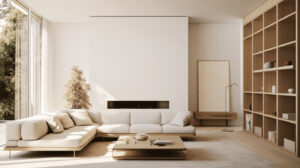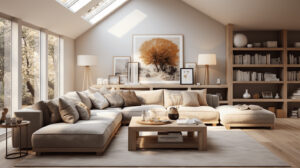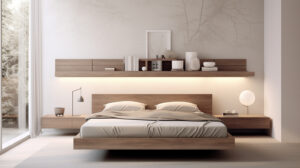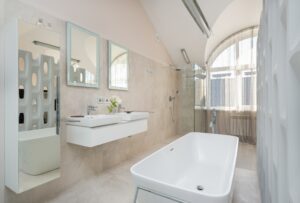Welcome to the world of minimalist design! In today’s fast-paced and cluttered world, many people are seeking simplicity and tranquility in their homes. Minimalist design offers the perfect solution, allowing you to create a stress-free and harmonious living environment.
Imagine walking into a home that is clean, uncluttered, and effortlessly beautiful. That’s the power of minimalism. By eliminating excess, focusing on essential elements, and embracing simplicity, you can transform your living space into a peaceful sanctuary.
Simple Minimalist Design for a Stress-Free Home

In this article, we will look through minimalist design for a stress-free home and how it can positively impact your life. We will discuss the benefits of minimalist design, practical tips for decluttering your space, choosing the right colors and materials, streamlining furniture and decor, creating functional and open spaces, incorporating minimalist principles in each room, promoting serenity with a minimalist lifestyle, embracing sustainability, finding balance, and personalizing your space.
Are you ready to embark on a journey toward a stress-free and serene home? Let’s dive in and unlock the power of simplicity!
Understanding Minimalism

In today’s fast-paced and cluttered world, many people are turning to minimalist design as a way to simplify their lives and create a more peaceful and stress-free home environment. But what exactly is minimalism and how can it benefit you? Let’s dive in and explore the concept of minimalism and its many advantages.
Definition of Minimalism
Minimalism is not just about having less stuff, but rather it is a mindset and a lifestyle choice that focuses on decluttering and simplifying all aspects of life. At its core, minimalism is about intentional living and only surrounding yourself with the things that truly add value and joy to your life.
By adopting a minimalist design, you can eliminate the excess and noise that can overwhelm your space and your mind. It is about finding beauty in simplicity and creating a harmonious balance between form and function.
Benefits of Minimalist Design
There are numerous benefits to incorporating minimalist design principles into your home:
- Reduced stress: A cluttered and chaotic environment can contribute to feelings of anxiety and overwhelm. By decluttering and simplifying your space, you can create a calm and serene atmosphere that promotes relaxation and peace of mind.
- Increased focus: When your surroundings are free from distractions, you can better focus on the tasks at hand. A minimalist approach can help eliminate visual clutter, allowing you to concentrate on what truly matters.
- Enhanced aesthetics: Minimalist design is known for its clean lines, uncluttered spaces, and neutral colors. These elements create a sense of sophistication and elegance in your home. Less is more, and the simplicity of minimalist design can create a timeless and visually appealing aesthetic.
- Improved functionality: Minimalism is all about practicality and functionality. By removing unnecessary items and focusing on the essentials, you can optimize your space and make it more efficient for your daily activities.
- Ease of maintenance: With fewer items to clean and organize, maintaining a minimalist home becomes much easier and less time-consuming. This frees up more time for you to focus on the things that truly matter to you.
By understanding the concept of minimalism and recognizing its benefits, you can begin to embrace this design philosophy and transform your home into a tranquil and serene oasis. So, are you ready to start decluttering and simplifying your space? Let’s explore some practical tips on how to do just that in the next section.
Stay tuned!
Decluttering Your Space

When it comes to minimalist design, decluttering is absolutely essential. By removing unnecessary items and organizing your essentials, you can create a serene and stress-free environment in your home. Here are some tips to help you declutter your space:
Removing Unnecessary Items
- Take inventory: Start by going through each room and taking note of items that you no longer need or use. This could include old clothes, duplicate kitchen gadgets, or unused furniture.
- One-in, one-out rule: For every new item you bring into your home, try to get rid of something else. This will help you maintain a clutter-free space in the long run.
- Donate, sell, or toss: Sort your items into three categories: donate, sell, or toss. Items in good condition can be donated or sold, while anything broken or unusable should be thrown away.
Organizing Essentials
- Designate storage areas: Establish specific areas in your home where you can store your essentials. This could include shelves, cabinets, or drawers. Having designated spaces will make it easier to keep everything organized.
- Invest in storage solutions: Consider investing in storage solutions such as storage bins, boxes, or dividers. These can help you maximize space and keep your belongings neatly organized.
- Utilize vertical space: Make use of vertical storage options such as wall-mounted shelves or hanging racks. This will help free up floor space and give your home a more spacious feel.
Remember, the key to decluttering is being intentional about what you choose to keep in your space. Keep only the items that bring you joy or have a practical purpose. Let go of the rest.
Choosing Neutral Colors and Natural Materials

When it comes to minimalist design, choosing the right colors and materials is essential. A minimalist space should have a calming and serene atmosphere, and the use of neutral colors and natural materials can greatly contribute to achieving this aesthetic.
Here are some key points to consider when selecting colors and materials for your minimalist home:
Importance of Neutral Colors
Neutral colors play a crucial role in minimalist design, as they create a sense of space and allow other elements to stand out.
Here are some reasons why neutral colors are a popular choice in minimalist interiors:
- Versatility: Neutral colors like white, beige, gray, and taupe are versatile and can be easily paired with other colors and materials. This gives you the flexibility to change the overall look of your space without replacing major design elements.
- Calming Effect: Neutral colors have a soothing effect on the mind, making them perfect for creating a tranquil and stress-free environment.
- Timelessness: Neutral colors are timeless and never go out of style. They provide a clean and elegant backdrop for your minimalist design, allowing the focus to be on the simplicity and beauty of the space.
Embracing Natural Materials
In addition to neutral colors, incorporating natural materials is another important aspect of minimalist design. Natural materials bring warmth and texture to your space, creating a harmonious and grounded feel.
Here are some examples of natural materials that work well in minimalist interiors:
- Wood: Whether it’s hardwood floors, wooden furniture, or accents, wood adds a touch of nature to your space. Opt for lighter or medium-toned woods like oak or maple for a more modern minimalist look.
- Stone: Marble, granite, and travertine are all excellent choices for countertops, flooring, or accent pieces. The natural variations in these materials add visual interest while maintaining the simplicity of minimalist design.
- Metal: Incorporating metal elements such as stainless steel, brass, or copper can bring a sleek and industrial feel to your minimalist space. These materials work well in kitchens, bathrooms, and lighting fixtures.
- Natural Fabrics: Choose organic cotton, linen, or wool for your upholstery, curtains, and bedding. These materials are not only environmentally friendly but also add a soft and cozy touch to your minimalist home.
By choosing neutral colors and natural materials, you can create a minimalist space that is visually appealing, calming, and sustainable. Remember, simplicity is the key to a stress-free home, and these design choices will help you achieve just that.
“In a world of constant distractions and visual clutter, the serenity of a minimalist space created with neutral colors and natural materials can provide a much-needed respite.”
Streamlining Furniture and Decor

When it comes to creating a minimalist home, streamlining your furniture and decor is essential. The goal is to embrace simplicity and reduce visual clutter, allowing your space to feel more open and serene.
Here are some tips to help you streamline your furniture and decor:
Furniture with Clean Lines
- Opt for furniture pieces that have clean lines and a minimalistic design. Avoid furniture with too many intricate details or excessive embellishments.
- Choose furniture made of materials like wood, metal, or glass, as they tend to have a more streamlined and modern look.
- Keep your furniture arrangements simple and uncluttered. Avoid overcrowding your space with too many pieces.
Multifunctional Furniture
- Maximize the functionality of your space by investing in multifunctional furniture. These pieces serve multiple purposes and eliminate the need for excess furniture.
- Consider a sofa that can also be converted into a bed for guests, or a coffee table with built-in storage compartments for magazines and remote controls.
- Look for furniture that can be folded, stacked, or easily moved around to adapt to different needs and situations.
Minimalist Decor
- Choose decor items that are simple and have a purpose. Avoid decorative pieces that serve no practical function and only add to the visual clutter.
- Stick to a few key decor items that have a visual impact rather than filling every corner with small trinkets.
- Incorporate natural elements like plants or a statement piece of artwork to add visual interest without overwhelming the space.
Remember, the key is to create a sense of calm and order in your space. By streamlining your furniture and decor, you can achieve a minimalist look that is both aesthetically pleasing and functional.
Creating Functional and Open Spaces

When it comes to creating functional and open spaces in your home, minimalism is key. By simplifying the layout and design, you can optimize the functionality of each room and create a sense of openness that promotes a stress-free environment.
Here are some tips to help you achieve this:
Open Floor Plans
One of the main features of minimalist design is the use of open floor plans. By eliminating unnecessary walls and barriers, you can create a seamless flow between different areas of your home. This not only makes the space feel larger but also encourages interaction and connectivity between family members or guests.
Maximizing Natural Light
Natural light is an essential element in creating a functional and open space. It not only enhances the aesthetics of the room but also improves the overall mood and wellbeing of its occupants.
Here are a few tips to maximize the natural light in your home:
- Use sheer or light-colored curtains to allow sunlight to filter through.
- Position mirrors strategically to reflect natural light and make the space appear brighter.
- Keep windows unobstructed by furniture or decor.
Efficient Storage Solutions
In a minimalist home, clutter is minimal, and storage solutions are essential to achieve this. Here are some ideas to incorporate efficient storage solutions into your space:
- Invest in sleek and streamlined furniture with built-in storage compartments.
- Use modular shelving systems that can be customized to fit your needs.
- Opt for hidden storage solutions like under-bed storage, wall-mounted cabinets, or storage ottomans.
By integrating these efficient storage solutions into your space, you can keep your belongings organized and hidden away, giving your home a clean and clutter-free appearance.
“By simplifying the layout and design, you can optimize the functionality of each room.”
Creating functional and open spaces in your home is all about focusing on simplicity and purpose. By decluttering, maximizing natural light, and utilizing efficient storage solutions, you can create a space that is not only visually appealing but also practical for everyday living.
Remember, less is more when it comes to minimalist design. Embrace the concept of minimalism and let your space breathe. Keep in mind that functionality and simplicity go hand in hand, and by implementing these principles, you can create a stress-free and harmonious environment in your home.
Incorporating Minimalist Design Principles in Each Room
When it comes to incorporating minimalist design principles into each room of your home, it’s important to focus on simplicity, functionality, and purpose. By embracing minimalism, you can create a space that is not only visually appealing but also promotes a sense of calm and tranquility. So, whether you’re revamping your living room, bedroom, kitchen, or bathroom, here are some tips for incorporating minimalist design in each room:
Living Room

The living room is often the heart of the home, where you relax, entertain, and spend time with loved ones. When it comes to minimalist design in the living room, less is more. Consider these ideas:
- Declutter: Remove unnecessary items and only keep the essentials. Opt for a simple and uncluttered layout.
- Neutral color palette: Choose neutral colors like whites, grays, and beiges for your walls and furniture to create a serene and spacious atmosphere.
- Functional furniture: Invest in furniture with clean lines and multifunctional features. Choose pieces that serve a purpose while maintaining a minimalist aesthetic.
Bedroom

The bedroom should be a sanctuary for rest and relaxation. Here’s how you can incorporate minimalist design principles in your bedroom:
- Minimize distractions: Keep the space free of clutter and distractions. Remove unnecessary furniture and decorations.
- Simple bedding: Opt for clean and minimalist bedding in neutral colors. Choose high-quality materials for a luxurious touch.
- Effective storage solutions: Utilize smart storage solutions to keep your belongings organized and out of sight. Consider built-in closets or under-bed storage.
Kitchen

The kitchen is often a gathering place and the hub of activity in the home. Here’s how you can incorporate minimalist design in your kitchen:
- Clean countertops: Keep your countertops clutter-free by only keeping essential kitchen appliances and tools.
- Sleek cabinetry: Choose kitchen cabinets with clean lines and a simple design. Avoid excessive ornamentation.
- Efficient organization: Utilize drawer dividers, storage containers, and vertical organizers to keep your kitchen essentials organized and easily accessible.
Bathroom

The bathroom is a place for relaxation and self-care. Here’s how you can create a minimalist bathroom:
- Simplify your essentials: Keep your bathroom countertop free of excessive products. Store daily essentials in a clean and organized manner.
- Neutral color schemes: Opt for neutral colors like whites, creams, or pastels for a clean and serene atmosphere.
- Minimalist fixtures: Choose simple and sleek fixtures like a wall-mounted sink or a frameless shower enclosure to create a minimalist vibe.
Remember, minimalism is not about sacrificing style or comfort; it’s about streamlining and simplifying your space to promote a sense of peace and serenity. Incorporating minimalist design principles in each room of your home can help you create a stress-free and harmonious environment. So, embrace simplicity, declutter, and focus on functionality to create a minimalist haven that reflects your personal taste and lifestyle.
Promoting Serenity with Minimalist Lifestyle

In today’s fast-paced and cluttered world, finding moments of serenity and peace can be a challenge. The minimalist lifestyle offers an inviting solution to promote tranquility and well-being. By embracing minimalism, you can create a living space that fosters calmness and allows you to disconnect from the chaos of daily life.
Here are some ways to promote serenity with a minimalist lifestyle:
Digital Detox
In our modern age, it’s easy to get absorbed in the constant stream of technology and information. A minimalist lifestyle encourages you to take a step back and have a digital detox. Set aside dedicated time each day or week where you disconnect from your devices. Use this time to engage in activities that bring you joy and help you unwind, such as reading a book, going for a walk, or practicing meditation. By giving yourself a break from the constant barrage of notifications and distractions, you can reclaim your serenity and find inner peace.
Implementing Daily Rituals
Rituals can be powerful tools for promoting serenity and mindfulness in your everyday life. Embrace the minimalist lifestyle by incorporating simple and meaningful rituals into your daily routine. This could be as simple as brewing a cup of tea in the morning and savoring it in a quiet corner or taking a few moments each evening to write in a gratitude journal. These small acts can help you slow down, stay present, and appreciate the beauty in the ordinary.
Mindfulness Practices
Mindfulness is a key component of the minimalist lifestyle that can greatly contribute to promoting serenity. Being fully present in the moment allows you to let go of worries about the past or future and connect with your inner calm. Incorporate mindfulness practices such as meditation, deep breathing exercises, or yoga into your daily routine. These practices can help you cultivate a sense of peace and serenity, allowing you to navigate life’s challenges with grace.
By embracing a minimalist lifestyle and incorporating these practices into your daily routine, you can promote serenity and create a peaceful sanctuary within your home. Remember, the goal is to simplify your surroundings and your mind, allowing space for tranquility to flourish.
“Minimalism is the intentional promotion of the things we most value and the removal of anything that distracts us from it.” – Joshua Becker
Sustainability and Minimalism

As we strive to live a more environmentally conscious and sustainable lifestyle, minimalism plays a significant role in reducing our ecological footprint. By adopting minimalist design principles, we can not only create a serene and clutter-free space but also contribute towards a greener planet. Let’s explore how sustainability and minimalism go hand in hand.
Reducing Environmental Impact
One of the core principles of minimalism is reducing waste and consumption. By minimizing the number of items we own, we reduce the need for production and ultimately decrease our environmental impact. Here’s how:
- Less Waste: When we have fewer possessions, we generate less waste. We don’t accumulate unnecessary items that would eventually end up in landfills.
- Energy Efficiency: A minimalist lifestyle encourages us to be mindful of energy consumption. With fewer electronics and appliances, we can significantly reduce our energy use and reliance on fossil fuels.
- Responsible Consumption: Embracing minimalism means carefully considering our purchases and opting for sustainable, high-quality products that are built to last. This reduces the need for frequent replacements and reduces the demand for cheap, disposable items.
Choosing Sustainable Products
In addition to decluttering our living spaces, minimalism also encourages us to make conscious choices when it comes to the products we bring into our homes. When selecting furniture, décor, and household items, consider the following practices:
- Ethical Sourcing: Look for products that are ethically sourced and made from sustainable materials. This could include furniture made from reclaimed wood, textiles made from organic and fair-trade materials, and eco-friendly cleaning products.
- Supporting Local and Small Businesses: Opt for products from local artisans and small businesses. Not only does this promote local economies, but it also reduces the environmental impact of long-distance shipping.
- Multi-functional and Durable: Choose items that serve multiple purposes and are built to last. This minimizes consumption and reduces waste in the long run.
By incorporating sustainable practices into our minimalist lifestyle, we can create a lasting positive impact on the environment while enjoying a clutter-free and serene home.
“Minimalism is not about removing beauty from our lives, but rather removing excess to make room for what truly matters – a sustainable and fulfilling life.”
Finding Balance and Personalizing Your Space

While minimalism emphasizes simplicity and minimalistic design, it doesn’t mean that your space has to be devoid of personality and warmth. Balancing minimalism with personal touches can create a space that reflects your individuality while still maintaining a clutter-free environment.
Here are some tips to help you find that balance and personalize your minimalist space:
Adding Simple Touches
- Incorporate a few carefully selected decorative items that bring you joy and contribute to the overall aesthetic of the room. These items should be intentional and meaningful, rather than cluttering up the space.
- Choose pieces that align with your personal style and preferences. Whether it’s a piece of artwork, a unique sculpture, or a family heirloom, make sure it speaks to you and adds value to the space.
- Opt for minimalist-inspired accessories such as a sleek vase, a minimalist clock, or a simple geometric rug. These subtle touches can add a touch of warmth and personality without overwhelming the overall design.
Displaying Sentimental Items
- Select a few sentimental items that hold significance to you and incorporate them into your minimalist space. These items can serve as focal points or conversation starters.
- Utilize minimalist display techniques to showcase your sentimental items without cluttering the space. For example, create a curated gallery wall with a few special photographs or display a cherished collection on open shelves.
- Rotate your displayed items periodically to keep the space fresh and prevent it from feeling stagnant. This way, you can showcase different sentimental pieces while still maintaining a minimalist aesthetic.
Remember, the goal is to strike a balance between minimalism and personalization. Each item you choose to display or incorporate into your space should have a purpose and bring you joy. Embrace the power of simplicity while still infusing your space with elements that are meaningful to you.
“Minimalism is not the lack of something. It is the perfect amount of something.” – Nicholas Burroughs
Also read; Upcycling and Repurposing: Giving New Life to Old Furniture
Conclusion
In conclusion, adopting a minimalist design for your home can have a profound impact on your overall well-being and create a peaceful, stress-free environment. By understanding the principles of minimalism and applying them to each room, you can create a space that promotes simplicity, functionality, and serenity.
Decluttering your space and getting rid of unnecessary items will help open up your home and create a sense of order. Choosing neutral colors and natural materials will bring a sense of calm and harmony to your space. Streamlining furniture and decor with clean lines and opting for multifunctional pieces will maximize both space and functionality.
Creating functional and open spaces, maximizing natural light, and implementing efficient storage solutions will allow you to make the most of your living areas. Incorporating minimalist principles in each room, such as incorporating simplicity and purpose, will create a cohesive design throughout your home.
Embracing a minimalist lifestyle goes beyond just the physical aspects of design. Implementing digital detoxes, daily rituals, and mindfulness practices will further promote serenity and reduce stress. Additionally, considering sustainability and reducing environmental impact by choosing sustainable products aligns with the ideals of minimalism.
While minimalism encourages simplicity and reduction, it doesn’t mean your home has to lack personalization. Adding simple touches and displaying sentimental items can still create a sense of warmth and personality in your space.
Overall, minimalist design offers a holistic approach to living. Its emphasis on simplicity, functionality, and mindfulness can transform your home into a sanctuary that promotes relaxation and well-being. By adopting the power of simplicity, you can create a stress-free living environment that enhances your quality of life.
Frequently Asked Questions
- What is minimalist design?Minimalist design is a style that emphasizes simplicity, with clean lines, open spaces, and a focus on essential elements. It eliminates unnecessary clutter and promotes a sense of calm and tranquility.
- What are the benefits of minimalist design in a home?Minimalist design in a home can help reduce stress by creating a clutter-free and organized space. It promotes relaxation, improves focus, and makes it easier to maintain cleanliness. It also allows for better utilization of space.
- How can I create a minimalist design in my home?To create a minimalist design in your home, start by decluttering and getting rid of unnecessary items. Use a neutral color palette, choose furniture with simple lines, and maximize natural light. Organize your space efficiently and focus on quality over quantity.
- Is minimalist design suitable for all types of homes?Yes, minimalist design can be applied to any type of home, regardless of size or architectural style. The key is to prioritize simplicity and functionality, adapting the design principles to suit your specific space.
- Can minimalist design be warm and inviting?Absolutely! Minimalist design can be warm and inviting by incorporating cozy textures, soft lighting, and personal touches such as artwork or plants. It’s about creating a space that feels welcoming and comfortable, while still maintaining a clean and uncluttered aesthetic.

